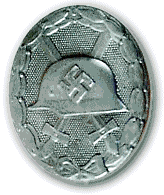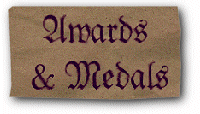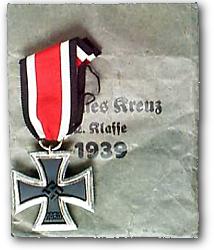Iron Cross Ist Class
Eisernes Kreuz 1. Klasse
The next succession in the Iron Cross
series was the Iron Cross Ist. Class. This award, like the Iron cross 2nd
Class, came into being on September 1, 1939. The criteria for the award
were much the same as the 2nd Class except that three to five additional
acts of bravery were required. |
|

Wound Badge
Verwundeten - Abzeichen |
Wound Badge
Verwundeten - Abzeichen
On September 1. 1939, Hitler reinstituted
the wound badge. The basic design was the same as the World War One design
with the addition of the swastika and the M35 helmet. All military, non-military
uniformed formations and later civilians wounded in air raids were eligible
for the award. It came in 3 classes:
1.Black -one or two wounds
2.Silver -three or four wounds
3.Gold -five or more wounds
This progression was waived in the
event of a severe wound in which case the silver was automatically awarded. |
|

Heeresbergeführer Badge |
Mountain Proficiency Badge
Heeresbergeführer Badge
The Bergführer breast badge was a coveted award as
well as being a mark of proficiency, worn only by those Army mountain troops
who acted as a mountain guide, and had a had one year's qualifying experience
in this active role.
The Heer Mountain Guide has a dull
silver finish and features a metal edelweiss with a golden heart set on
a dark green enamelled oval, edged in gold. The same colour is used for
the Heeresbergeführer lettering. Instituted in the 1930's, this insignia
was already on issue in the days of the Reichswehr. |
|
|
|
Iron Cross II
Class
Eisernes Kreuz 2. Klasse
The Iron Cross II class came into
existence with the institution of the award on Sept. 1. 1939. It was authorised
for the single act of bravery in combat beyond the normal fulfilment of
duty. It could be awarded to all members of the Wehrmacht and those organisational
personnel in direct support of the military.
|
|

The General Assault Badge
Das Sturmabzeichen |
The
General Assault Badge
Das Sturmabzeichen
Issued under orders of the OKW {same
order which authorized the Infantry Assault Badge: Army Regulations, Section
B, Publication 56, Page 379} on 1 June 1940. It was awarded to assault
artillery personnel, "...Who along with other infantry or armoured units
as well as their own units who may qualify for the Infantry Assault Badge."
Award authority was with the division commander. This included engineers
{Pionier} and anti-tank units {Panzerjäger}. The badge was designed
by jeweller Ernst Peekhaus of Berlin.
The badge was awarded in one grade
only until 1943, when the four classes, II {for 25 assaults}, III {for
50 assaults}, IV {for 75 assaults} and V {for 100 assaults} were created.
The basic badge was awarded after three offensive actions, later amended
to three actions, involving combat with an enemy force. The further classes
were awarded on a combat time basis {for example, 7 months' service in
the line counted as 10 assaults}.
Surrounded by the traditional oak
leaves and acorns, the eagle represented the German Wehrmacht, and the
stick grenade and bayonet the weapons of close combat. This same motif
was used in the design of the Close Combat Clasp. |
|

Nahkampfspange |
Close Combat Bar
Nahkampfspange
Effective 25. November 1942 Hitler
ordered that all officers and men of the Army who engaged in hand-to-hand
combat when unsupported by armour would be recognised for their heroism
providing they qualified. The bar was struck in bronze, silver and gold
(this example) for 15, 30 and 50 days respectively of hand-to-hand or in
close-combat, the criteria was reduced to 10, 20 and 40 days respectively.
The bar was primarily for award to
Infantry soldiers, however other units were also eligible. Retroactive
credit was authorised for those persons who took part in the Russian Campaign
from June 1941 onwards, a service to combat days ratio was established
on the following scales:
5 combat days were credited for 8 months
service.
10 combat days were credited for 12 months service.
15 combat days were credited for 15 months service. |
|
|




